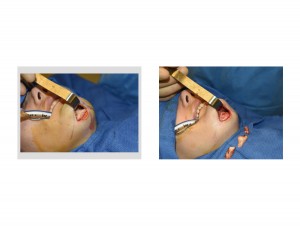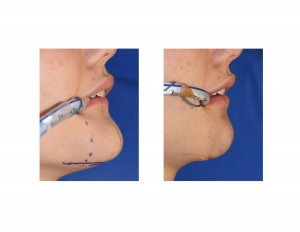The treatment of macrogenia (large chin) is much different than that of microgenia (small chin) and is also more challenging. Expanding the chin (chin augmentation) can done very reliably and in a straightforward manner through an implant or sliding genioplasty as it pushes out the overlying skin and soft tissue. While a prominent chin bone can be reduced, the success of any chin reduction procedure usually depends on what happens to the resultant excess soft tissue that will result from loss of bone support.
While a few limited chin reductions can be done from an intraoral approach, significant chin reductions require a different approach for two reasons. First, significant chin reduction requires a multi-dimensional approach to the bone reduction. This often includes horizontal, vertical and width bone removals. If the surgeon is skilled in bony genioplasty techniques and the patient is young, an intraoral vertical and midline wedge bone removals can reshape a large chin. But the best access to doing every dimension of bony chin change is from a submental approach from below. Secondly, any successful management of excess chin soft tissue involves excision which can only be done from below. Resuspension or ‘tightening’ of chin tissues done intraorally is not really an effective method making the chin soft tissues less in volume.
A submental chin reduction has several key technical steps to be successful. These include the location and extent of the incision, the method of bone removal and tye closure method which includes a submental tuck-up procedure,



The technique for submental chin reduction is not well described or frequently performed. But careful attention to detail can create a submental scar that is both very aesthetically acceptable and not overly long.
Dr. Barry Eppley
Indianapolis, Indiana


